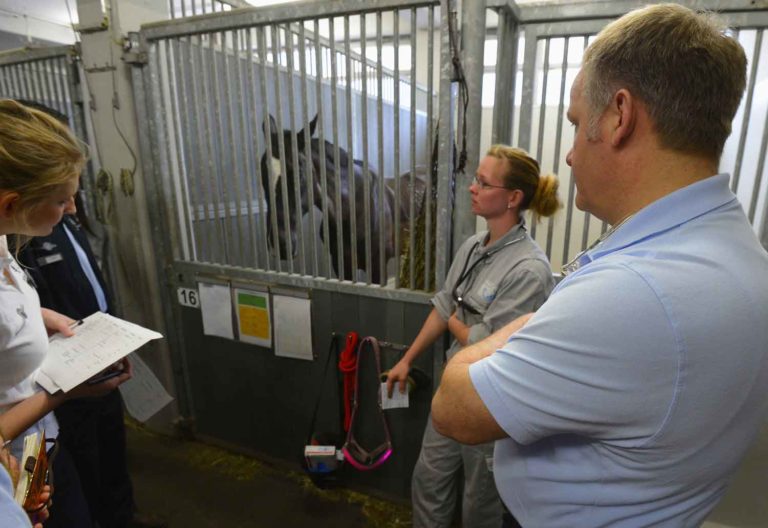
At first inspection, a horse with a respiratory infection might simply show malaise and have a fever. While this might seem relatively inconsequential, it is important to take proactive steps to avert an outbreak in case the sickness is due to equine herpesvirus (EHV-1). What might initially appear to be a transient viral infection can turn into a far more difficult and potentially fatal condition of EHV-1 herpes myeloencephalopathy (EHM).
Transmission of Herpesvirus
Herpesvirus tends to infect horses at an early age. Estimates show that 80-90% of horses are exposed to herpesvirus before 2 years of age. Once infected, herpesvirus persists for the life of a horse, although the horse usually does not show overt clinical signs.
EHV-1 is highly infectious and transmissible through fomites, aerosols, an aborted fetus or placental tissues, or through direct horse-to-horse contact of nasal mucus. Horizontal exposure from broodmare to foal can pass the virus transplacentally. Horses can also be exposed through embryo transfer techniques. Transmission between dam and foal is particularly likely during periods of recrudescence from stress associated with pregnancy and foaling.
Intestinal Tract and Nervous Tissue
Although shedding of herpesvirus usually passes through nasal secretions or contact with placenta and aborted tissues, the virus can enter the intestinal tract and nervous tissue through systemic infection, viral replication or swallowing of contaminated nasal material. Excretion of virus into the feces potentially occurs within just a couple of days. Therefore, it is important to manage the disposal of manure and bedding with careful biosecurity protocols.
Aerosol Transmission
Herpesvirus-contaminated airborne respiratory droplets can travel many feet to cause aerosol transmission. The exact distance over which this may occur is not known. However, 30 yards is an estimate of the maximal distance for spread. Because of the possibility of aerosol transmission between horses, sick and exposed animals should be isolated at an appropriate distance. The potential for aerosol transmission depends on many viral and environmental factors. These include temperature, humidity, airflow, virus size and the nature of the fluid containing viral-laden droplets.
Transmission Through Fomites
Fomites are an important source of transmission. The virus remains stable and infectious for up to seven days on wood, paper and rope. On other materials, like leather, fabric, wood shavings, wheat straw and polystyrene, herpesvirus is viable for 48 hours. There are reports of the virus remaining viable on horse hair for up to 42 days. Movement of people and equipment around a facility can carry the virus from one area to another on hands, clothing, boots and equipment, even if the horses are carefully separated. Biosecurity protocols should mitigate this possibility.
Transmission Through Water
Water is another vector for transmission of herpesvirus and other equine viruses. In water, EHV-1 remains relatively stable in temperatures of 39-86 degrees F, especially with sediments in the water that protect against ultraviolet damage. Because shared water sources present a potential for viral spread, individual horses should have separate water vessels.
How Equine Herpesvirus Persists in an Infected Horse
Adaptation of equine herpesvirus within a horse host enables the virus to undergo a period of latency. During this time, an affected horse shows no clinical signs of infection but can actively shed the virus.
EHV-1 can infect many equine cell types: endothelial cells of inner organs, respiratory epithelial cells and mononuclear cells in lymphoid organs and peripheral blood. Latent virus hides out in lymphocytes and/or sensory nerve cell bodies within trigeminal ganglia. Reactivation of virus—particularly during periods of stress—enables it to spread to susceptible horses through the respiratory tract. Not all “infected” horses show signs of illness. Some are simply silent shedders that transmit the virus to immunologically naïve individuals.
In its respiratory form, EHV-1 leads to fever and respiratory disease that also interrupts training and competition schedules. The virus can trigger abortion in the last trimester. Of considerable concern is its role in outbreaks of severe neurologic disease—equine herpes myeloencephalopathy or EHM—which can be potentially fatal. One horse developing EHM sets off a chain of biosecurity events. Usually, large groups of exposed horses need to be quarantined. This can have significant economic impacts on training and competition schedules.
Replication in Respiratory Nasal and Mucosal Epithelial Cells
Within 1-3 days of exposure, herpesvirus replicates in respiratory nasal and mucosal epithelial cells. The virus is shed in nasal discharges. There is often a biphasic fever on days 1-2 and again on days 6-7. However, not all affected horses develop fever. A sick horse presents with nasal discharge, coughing, depression, anorexia, and occasionally enlargement of retropharyngeal lymph nodes. The respiratory form tends to run its course within a couple of weeks, although individuals occasionally develop mild forms of equine asthma. In some cases, particularly foals, EHV-1 respiratory infection might elicit ocular lesions of chorioretinitis or uveitis.
Detection Within Lymph Nodes
The virus is detected within regional lymph nodes of the respiratory tract within 12 hours of exposure. This is due to interaction with the host immune system that triggers an inflammatory response of cytokines. While cytokines can eliminate the viral antigen, responses can also induce proinflammatory cytokines and activated coagulative responses that are counterproductive to defeating the consequences of infection.
Invasion of Deeper Tissues
From the upper respiratory tract, EHV-1 invades deeper into the tissues via infected monocytes. Then it enters the reticuloendothelial system and the lymphatics to infect circulating leukocytes and endothelial cells of blood vessels. With viremia, EHV-1 can potentially enter the pregnant uterus or invade the central nervous system to incite myeloencephalopathy. Effects in the pregnant mare result in spontaneous abortion from endothelial cell invasion generally within 9-13 days following infection or reactivation from latency. In addition, EHV-1 can cross the blood-testis barrier to be shed in semen for up to one month following viremia.
Equine Herpesvirus Myeloencephalopathy (EHM)
Up to 10% of EHV-1 infected horses develop equine herpes virus myeloencephalopathy (EHM). A single point mutation difference between EHV-1 and EHM has been isolated to differentiate wild-type N752 and non-neuropathogenic D752 strains.
EHM clinical signs appear 1-2 weeks after EHV-1 infection. They often coincide with the second round of fever, with or without respiratory signs. Cell-associated viremia affects the vascular endothelium of the central nervous system despite high levels of circulating antibodies. Damage to the vascular endothelium occurs either directly during viral replication and/or from immune complexes that form between EHV-1 and antibodies. Vascular damage leads to thrombo-ischemic necrosis of the microvasculature of the brain and central nervous system.
Clinical signs of EHM include incoordination, stiffness, weakness with hind limbs worse than forelimbs, loss of tail tone, dog-sitting position or recumbency, spastic bladder and loss of tone with urine dribbling or inability to urinate, and occasional cranial nerve deficits. EHM is associated with 30% mortality. Horses that recover might have persistent neurologic deficits.
Treatment of EHV-1 and EHM
If you suspect that a horse has EHV-1 and/or EHM, or if there are any indications of an outbreak, you must perform nasal swabs and collect whole blood samples for laboratory examination to make a definitive diagnosis.
Treatment focuses on supportive care and ensuring that the horse can pass urine and manure. Reports of anti-viral medications demonstrate some efficacy in managing EHM-affected horses. Infected and exposed horses are isolated with strict biosecurity protocols put in place.
- In one study, horses receiving valacyclovir experienced less viremia and shed less virus compared to the control group. Horses receiving prophylactic valacyclovir for two weeks had lower rectal temperatures, improved clinical scores (respiratory rate, heart rate and nasal discharge) and decreased viremia than control horses. While the risk of ataxia wasn’t affected by treatment, its severity was decreased in valacyclovir-treated horses compared to control horses.
- Valacyclovir combined with heparin is a targeted treatment that can significantly decrease development and severity of EHM during an EHV-1 outbreak. In a study of 23 EHV-1-positive horses, 19 received the combined treatment and survived, with six eventually returning to their previous level of work. Four EHM-positive horses that received neither heparin nor valacyclovir developed advanced neurologic signs of EHM and were euthanized.
- A study combining aspirin and valacyclovir revealed that valacyclovir did not affect the duration or magnitude of fever, but it decreased the number of new fevers. Valacyclovir also did not affect the number of cases that developed EHM (27%) or the likelihood of euthanasia. While aspirin did not alter the number of EHM horses that developed recumbency, it did improve survival. The study estimated that without the use of aspirin there could be a 45-times greater risk of euthanasia.
Prevention and Vaccination
Current USDA-licensed EHV-1 vaccines are not effective against EHM because they don’t have the ability to block cell-associated viremia that deters entry of virus into the central nervous system or uterus. The one thing that EHV-1 recombinant vaccines accomplish is reduction of initial nasal viral shedding in vaccinates, which is important to mitigate risk of transmission to naïve horses. It is recommended to vaccinate every horse at risk of exposure to EHV-1 to help reduce the severity of EHV-1-related clinical manifestations. For prevention, new horses entering a property should be isolated and monitored for 2-3 weeks, and caution should be taken at events and competitions where intermingling with other horses is likely.
The Equine Disease Communication Center (EDCC) is an invaluable resource for veterinarians to upload current disease outbreak information and to find out general geographic locations of current cases. This website (https://www.equinediseasecc.org) is updated regularly with real-time alerts and information for mitigation and prevention of all equine infectious diseases. There is also a list on the EDCC website of appropriate biosecurity measures for prevention and strategies to implement during an infectious disease outbreak.

![[Aggregator] Downloaded image for imported item #18782](https://s3.amazonaws.com/wp-s3-equimanagement.com/wp-content/uploads/2025/11/03125751/EDCC-Unbranded-13-scaled-1-768x512.jpeg)


